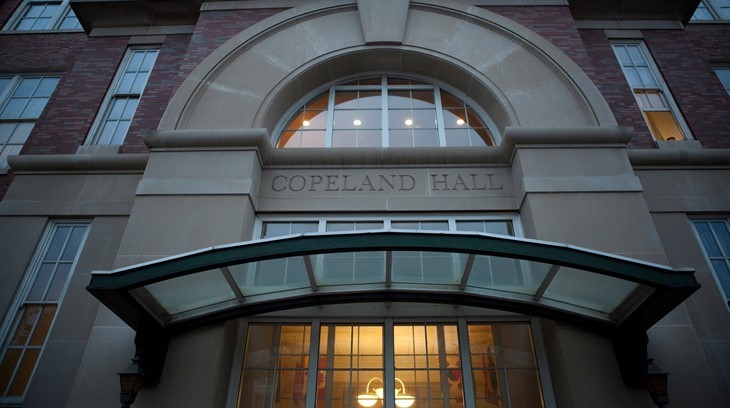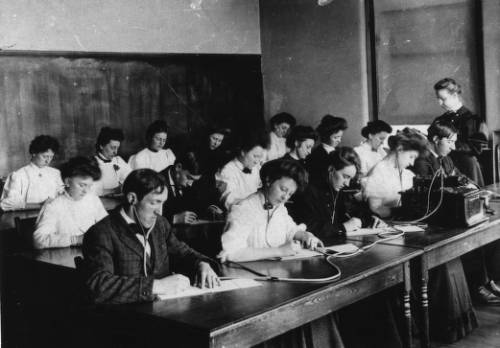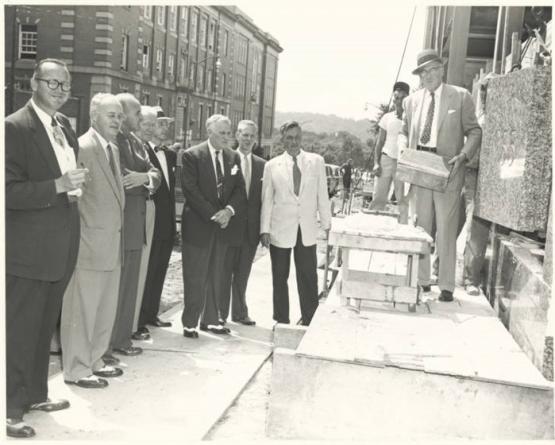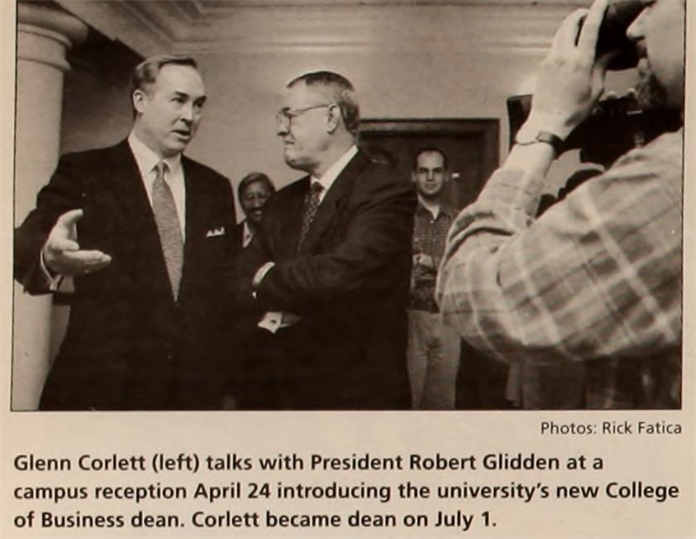College History
Follow the COB's roots from 1836 to construction of Copeland Hall in 1955 to today.
Ohio University, the oldest college in the state, was founded on February 18, 1804 and opened its doors to students in 1808 with one building, three students and one professor, Jacob Lindley. Below is a brief timeline of the rich history of Ohio University's College of Business located in Athens, Ohio.
The 1800s
1836 — Ohio University offers commercial subjects, not carrying college credit, to prepare students for “clerkships and business pursuits.”
1893 — Classes in stenography, bookkeeping, and typing were offered as adjunct courses to the regular curriculum, particularly in summer school. As the demand for practical business education skills increased, the classes evolved into a two-year certificate program, and eventually, the College of Business Administration.
1893 — Ewing Hall was completed in March 1898. It stood on College Green between E.W. Scripps and Wilson Hall. Tupper Hall (Old) was relocated to behind Manasseh Cutler Hall to make room for Ewing Hall. It housed administrative offices, the auditorium, and classrooms. It was the first home of the Ohio University Credit Union. Ewing Hall was demolished in November 1974. The stained glass windows were salvaged, put in storage for nearly 30 years, then restored and installed in Walter Hall. Scripps Amphitheater was built on the site in 1984.
Tuition for a full school year (three terms) was $21 per year with a $3 contingent fee, a total equivalent of about $757 today.
1896 — Copeland graduates from Ohio University with a Bachelor of Pedagogy.
1897 — The University founded a “commercial department,” with Copeland as principal. In 1913, his title changed to director. Ewing Hall was home to the department and eventual college during its early years.
Early 1900s
1901 — The department becomes the School of Commerce in the Normal College and continues to be led by Copeland. (*Note: conflicting information can be found as to when exactly Commerce became a department, school, and college. One source notes that the Commercial Department became the Commercial College in 1901. However, multiple sources confirm that the School of Commerce became the College of Commerce in 1936.)
1904 — The University issues its first certificate for completion of a four-year commercial course to Roy T. McClure of Bloomingsburg, Ohio, and claims that “no school in the country can show a larger percentage of its graduates at profitable employment." The school employs four faculty.
1916 — The school offers an A.B. in Commerce (ABC) and employs five faculty. Dean Burns Copeland (son of Charles Copeland) and Frank Joseph Hoden become the first graduates of the program in 1920.
1922 — University enrollment climbs to 1,515 and Commerce had eight full-time faculty plus four “conductors of extra courses” drawn from the business community. Subjects included negotiable contracts, accounting for coal production and distribution, and C.P.A. practice and problems.
1925 — The Alpha Omicron Chapter of business fraternity Delta Sigma Pi becomes the first student organization in Commerce. It was the only professional fraternity on campus to maintain a house as well as a social program for 10 years. The house closed in 1935 but continued its social status and became an honorary group.
1926 — After awarding 25 ABC degrees in 1925, the school made a commitment to the four-year degree by initiating the Bachelor of Secretarial Science (BSS) and discontinuing its two-year commercial course. Carroll Corrine Baker Hughes and Martha Calkins Miller received the first BSS degrees in 1928, nearly 55 years after Margaret Boyd became the first woman to graduate from Ohio University in 1873.
1936 — Copeland retires after many years of poor health.* Adolph H. “Army” Armbruster is recruited from the University of Pittsburgh School of Business Administration to direct 17 full-time and three part-time faculty. (*Note: based on conflicting information, it is unclear when exactly Charles Copeland retired, but he may have done so as early as 1934.)
President James establishes the College of Commerce which includes the accounting and economics department, political science, sociology, and the School of Journalism. Armbruster serves as the first dean.
Commerce enrollment was 323 students which was approximately 21% of the University’s total enrollment; the college employed 17 full-time faculty and three part-time faculty. Of the 323 students enrolled in Commerce, 248 students were men (77%) and 75 were women (23%).
The college establishes a B.S. degree in industrial engineering that is offered jointly with what is now the Russ College of Engineering and Technology. The program is offered as such until 1952.
Mid 1900s
1941 — Academic expansion halted as the United Stated entered World War II. Ohio University enrollment dropped below 1,500 students and commerce enrollment dropped as low as 100 students in 1944 (but will quickly recover after the war concludes).
Charles Copeland received the alumni association’s certificate of merit after years of interest and involvement in alumni affairs.
1943 — Armbruster is named acting dean of the engineering college and serves in that role until 1947. (It is assumed he simultaneously served as dean for both colleges.)
1944 — Charles Copeland dies on June 2, 1944 at the age of 75. Dr. Edwin Watts Chubb, dean of the College of Liberal Arts and a close personal friend, delivers his eulogy.
1949 — After the conclusion of World War II, faculty returned to Athens and the College of Commerce’s enrollment reached more than 1,128 students, many using GI benefits. The college employed 30 full-time faculty and several part-time faculty.
1950 — The college is accredited by the American Assembly of Collegiate Schools of Business (now the Association to Advance Collegiate Schools of Business, or AACSB). Unfortunately, Armbruster, who had put a great deal of energy into the accreditation, lived only one year after the process had been completed. After Armbruster’s death in 1951, William Fenzel, professor of accounting, took over as acting dean, and served as such for the next three years.
1952 — The college adds a management department thanks to the work of economics professors Albert Gubitz and Edwin Hellerbrandt.
1954 — The college creates the Ohio School of Banking to train young bank employees for executive careers.
Clark E. Myers, professor of production at Harvard Graduate School of Business, becomes second dean of the college and serves in the role until 1957, when he resigns to become the first director of the IMEDE program in Switzerland. Accounting professor Karl Krauskopf becomes acting dean in 1957 and serves in the role until 1960.
1955 — Construction begins on a five-story building that will eventually be dedicated as Copeland Hall. The project is estimated to cost $1,000,000 and had a capacity of 1,300 students. General classrooms and offices were on the first three floors, and the fourth floor was reserved for secretarial studies. A statistics laboratory was also located on the third floor.
Copeland Hall construction photo and Copeland Hall cornerstone ceremony photo from Ohio University Libraries Digital Archival Collections
1956 — The college adds an MBA to the curriculum thanks to an expanding curriculum and strong faculty. An executive MBA will eventually be added in 1977, and the Professional MBA (in Dublin, Ohio) in the spring of 2009.
1960 — Paul Noble becomes the third dean of the college and serves in the role until 1965.
An aviation program is created; the program is transferred to the engineering college in 1970.
1964 — The College of Commerce is renamed the College of Business Administration.
1965 — Harry Evarts becomes the fourth dean of the college and serves in the role until 1970 when he is named the president of Bryan College.
1966 — The college discontinues its degrees in secretarial studies and agriculture. Ohio University launches the world’s first Sports Administration program, led by Dr. James Mason after encouragement from professional baseball pioneer and Los Angeles Dodgers owner Walter O’Malley and Dr. Clifford Brownell (Columbia University). The program, originally hosted in what is now the College of Health Sciences Professions, later moves to the College of Business in 2010.
1968 — The School of Journalism moves from the College of Business Administration to become a part of the newly formed College of Communications.
1969 — The college’s master’s programs receive AACSB accreditation.
Late 1900s
1971 — John M. Peterson, a professor of economics at the University of Arkansas, becomes the fifth dean of the college and serves in the role until 1977.
1975 — The college launches a Bachelor of Business Administration with the Institute of Technology (ITM) in Malaysia.
1977 — Pro bono Executive in Residence R. Budd Werner becomes a founding member of the Executive Advisory Board (EAB) and works to recruit 29 business leaders to advise the college. Gerald Silver, acting dean of the Silberman College of Business Administration at Farleigh Dickenson University, becomes the sixth dean of the college and serves in the role until 1981. The Executive MBA is launched and taught by College of Business Administration Faculty on the Lancaster campus; Kahandas Nandola is named the first program director.
1978 — The Economics Department moves to the College of Arts and Sciences.
1981 — Management professor John Stinson becomes the seventh dean in the college’s history and serves in the role until 1987. From 1996 to 1997 he assumed the role for a second time, becoming the only person to do so in the college’s history.
1983 — The Copeland Scholars program is established to attract academically gifted students. The Computer Systems in Business (CSB) major is created and the college dedicated its first computer lab with 20 IBM personal computers. This is also the year that the college established selective admission criteria – the first college to do so at Ohio University.
1984 — Digital Equipment Corporation donates a VAX computer and personal computers for a second computer lab in the college and provides computers for all business faculty. The VAX is used to support the first email system for the entire university.
1987 — William A. “Bill” Day becomes the eighth dean of the college and serves in the role until 1993. The Corporate Leadership Program (now known as Select Leaders) was created to help undergraduate students build leadership abilities; 18 students join the inaugural program.
1990 — The Management Information Systems Department is established and updates the Computer Systems in Business program to what is now known as the Management Information Systems (MIS) major.
1991 — A relationship is established with Jannus Pannonius University (JPU) in Pecs, Hungary. One component of the partnership included an exchange where College of Business faculty traveled to JPU for a joint symposium. That same year, 18 students traveled from Ohio University to Pecs during spring break to complete a consulting project with students from JPU. This became the Joint Student Consulting Project (JSCP) in the MBA program and ultimately led to the Global Consulting Project (GCP) for undergraduate students.
1993 — C. Aaron Kelley becomes the ninth dean of the COB and serves in the role until 1996.
1993-95 — Copeland Hall undergoes a massive renovation and reopens in 1995.
1996 — The college’s first students participate in what is now known as the Global Consulting Program (GCP). The Integrated Business Cluster is developed and the first volunteer students participate in spring semester. Freshmen entering in the fall of 1997 will become the first to be required to complete the program in order to graduate. The college launches MBA Without Boundaries, Ohio University’s first online program.
1997 — Glenn E. Corlett becomes the tenth dean of the college and serves in the role until 2007. After four years of groundwork by alumni and friends, the college establishes a Sales Center – one of the first of its kind. The University’s Board of Trustees approve The Sales Centre as a fully recognized academic center.
Ohio University Alumni Journal Corlett clipping from Summer 1997 Ohio University Today retrieved from Internet Archive
2000s
2000 — The university’s sports administration department, which was located in Health Sciences at the time, launched a dual MBA/MSA program, which would soon become one of the top-ranked programs in the world for nearly a decade.
2001 — Selective admission criteria established more than 15 years ago help maintain undergraduate enrollment to just over 1,800 students. Residential graduate business programs enroll approximately 90 students.
2006 — A generous gift is made to the college’s sales education program and named The Ralph and Luci Schey Sales Centre.
2007 — Hugh D. Sherman becomes the eleventh dean of the College of Business. (In 2019, he announces his intent to retire from the position and return to the management faculty in the summer of 2020.)
2010 — The college enrolls its first students in the Professional Online Master of Sports Administration, a primarily online program for working professionals. The class becomes the first PMSA graduates in 2012.
2012 — Business’ Robert D. Walter Center for Strategic Leadership is established. The college launches an online MBA program that allows students to study from anywhere in the world. It’s the college’s first fully online program and features (what is now referred to as) the Leadership Development Conference, which brings students to campus for one weekend during their studies.
2016 — The university’s computer services center on President Street is converted to meet the needs of a growing College of Business. The Phil and Pat Muck Business Annex is opened in the fall along with a new finance lab in Copeland Hall that is equipped with multiple Bloomberg trading terminals. The college’s Center for Sports Administration, housed in the annex, is also named by American engineering and infrastructure firm “AECOM.” The College of Business celebrates being ranked the 38th best business school (15th best public business school) by Bloomberg BusinessWeek. It is the highest ranking in the college’s history.
2018 — College enrollment peaks at nearly 3,800 students thanks to growth in graduate and online programs. OHIO’s Online MBA is ranked 15th best in the nation by Poets & Quants, even though it was launched only six years before.
2019 — The college creates and launches new graduate programs for working professionals in business analytics, accountancy, and management. The college also launches its first graduate business certificates which can be earned as a standalone credential or applied as a stackable certificate towards a degree program (such as the new Master of Management). The college receives an extension of accreditation by AACSB.
2020 — After several years of investment in business-specific academic and career support services for students, all eleven of the college’s majors are offered as eligible programs of OHIO Guarantee+, a program that features fixed undergraduate tuition and fees, on-time graduation planning, and lifelong alumni/career benefits. During the spring semester, Ohio University transitioned all of its coursework to an online/virtual format as the world combatted the coronavirus pandemic. Business students and faculty responded in usual fashion with positivity and compassion, continuing engagement with one another from a distance. The college found ways to support the community and celebrate graduating seniors in unprecedented ways.
2021 — Jacquelyn Rees Ulmer became the dean of the College of Business on February 1. Dean Rees Ulmer is the first woman to serve in this role.
Sources
- Hollow, B. (2003). Ohio University, 1804-2004 the spirit of a singular place. Athens (Ohio): Ohio University Press.
- Copeland, D. B. (1973). The Copeland Story, 1899 – 1973.
- Williams, R. L. (2020). A Bulleted, Pictorial History of Ohio University. Athens (Ohio): Dr. Bob Productions.
- Mahn, R. E. (1956) "A Half-Century of Development Preceded Today’s School of Commerce." Athens (Ohio): The Ohio Alumnus.
- Hoover, T. N. (1954) The History of Ohio University. Athens (Ohio): Ohio University Press.
- Hellerbrand, T. (1986) Fifty Years: A Celebration.




